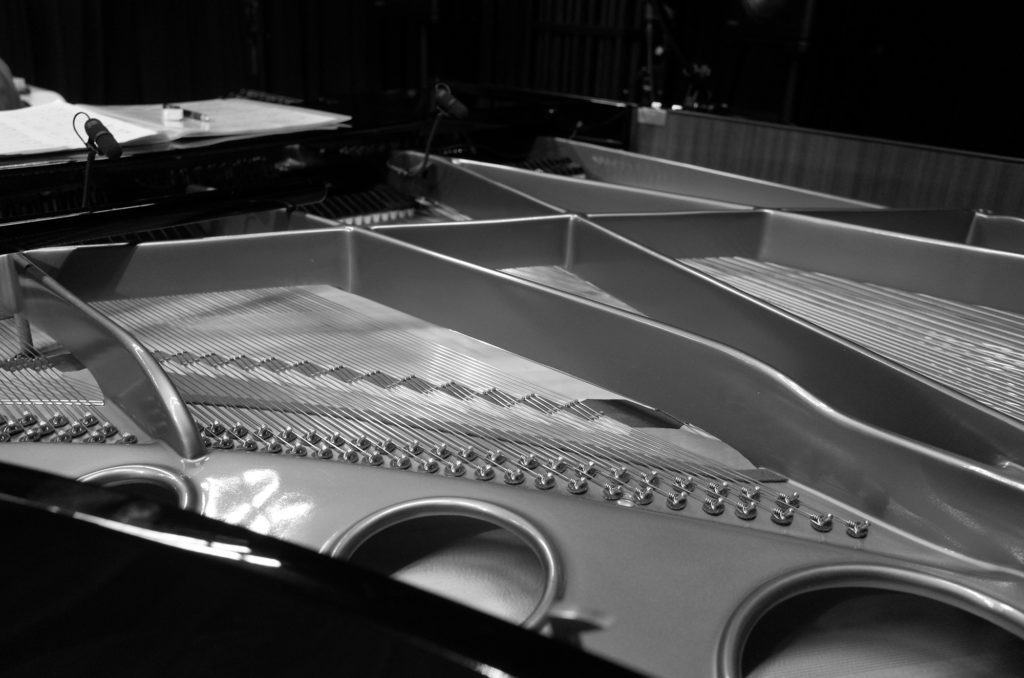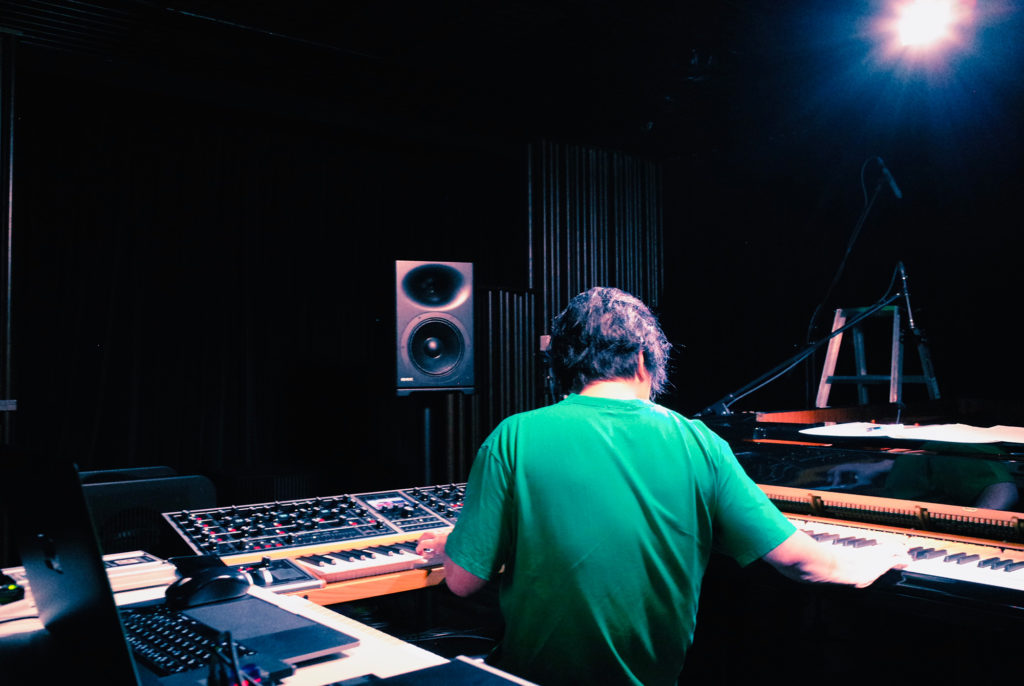Keiichiro Shibuya is a gifted musician that has continued to create fresh sounds by crossing different boundaries and evolving. He has been getting good feedback for ATAK024 Midnight Swan, his latest soundtrack album to the film Midnight Swan, and he is ready to show the world his highly anticipated android opera, Super Angels, next summer. This series, “Massive Life Flow,” explores his mindset and what he envisions for the future. In our second installment, he talked to us about how he felt towards his first-ever live stream concert “Keiichiro Shibuya – Playing Piano in the Distance”, held on September 25th, what he gained through the experience, and how live shows might change.
The wish to create something better than a live show, sonically and visually
—What were your initial thoughts on live streams?
Keiichiro Shibuya (Keiichiro): It’s hard to tell how live shows are going to be, but I had an inkling that virtual concerts were going to become one alternative. So, I wanted to play a live stream concert the right way.
People say live performances are better, no? Well, sonically and visually, well-recorded virtual shows can be better than live performances at a concert hall or live house. One splendid example is the Berliner Philharmoniker’s live streaming service called Digital Concert Hall. When I saw their videos during the stay-at-home period, I was so awestruck. First, the sound quality and editing were brilliant. And it was crucial to have a lot of cameras following the performers’ every move.
—So, the content was good, not just because of the sound, but its visual quality too.
Keiichiro: Everyone loves minimal, contemporary music like Philip Glass and Steve Reich, but when it gets more complicated than that, many people feel drained just from listening. The everyday listener can’t see the full picture when music has “random” elements. That is why it goes over their threshold. I get where they’re coming from, though. But whenever I listen to say, György Ligeti or Helmut Lachenmann, I think to myself, “this part sounds cooler than minimal or post-classical music, but I guess people don’t listen to this stuff because they can’t predict how it plays out.” I’ve thought about this since my college days.
What I was missing was the fact that visual information could be helpful in understanding music. I watched Lachenmann conduct “Concert Piece for Eight Horns and Orchestra” on Berliner Philharmoniker’s Digital Concert Hall the other day, and I saw how the cameras zoom in and focus on the orchestra and horn players’ hands. You understand how each sound is created by watching the movements, and before you know it, you’re listening to a complicated 20-minute piece with no problem. It made me appreciate how watching is conducive to listening to music. Once virtual concerts become more prevalent, I think we could develop a more comprehensive listening experience. Today, people compete to simplify their music as much as possible regardless of the genre, but after realizing the relationship between visual cues and music, I felt like that could change. There might be a possibility for there to be more intricate, exciting music. Perhaps, “seeing music changes the way you listen to music” is one example of transforming the invisible to the visible, triggered by this pandemic.
—I could see why you wanted to play a virtual show the right way. You thought you could do that at Rittor Base, the venue you chose for the online performance.
Keiichiro: Rittor Base is founded by Susumu Kunisaki, the former editor-in-chief of Sound & Recording Magazine, for 20 years. Kunisaki-san and I are friends, and so I trusted him. Also, Seigen Ono and zAk, who are my friends and prestigious audio engineers, told me that the sound system there was good. I felt like I could do something good in this new environment, so I used it.
Developing a unique style by playing the piano “the wrong way”
—Could you talk about what it was like to play a live-streamed concert with no physical audience?
Keiichiro: I have to concentrate hard whenever I play the keys, and so I find rustling noises to be distracting. One time, the MC was like, “you told staff to stop the AC, right?” That comment made the mood in the room so tense (laughs wryly). I could focus on the live-streamed concert. I also noticed how having a small team positively influences my concentration level.
—I could tell that you were concentrating very hard while playing the piano, even if it was through a screen. You didn’t feel you could relax even if a physical audience wasn’t present, then.
Keiichiro: Right. I used a lot of physical energy during that performance. I’ve once had a session with Naruyoshi Kikuchi during the day and Mirai Moriyama at night. I got so tired that time and my body ached for a while. Well, this time was the same. I realized I wasn’t spending my energy via the zeal of an audience.
The “correct,” classical way to play the piano is to let go of your body tension and play with ease. But that is not the way I play. If you want to play the piano in a way that incorporates noise music or anti-classical music, then the tones you could create by playing “correctly” will be limited. The sound texture you make hugely depends on the way you place your finger on a certain area of a certain key. I think about what sort of sound I want to produce every second I play. Also, I consider is how strongly I press down on the keys with my ten fingers. Therefore, I get told that the way I play has a clear, crisp sound or that it sounds different. I get exhausted because I use so much physical energy (laughs).
—Where does your piano-playing style come from?
Keiichiro: When I was in high school, there was a time where the late Reiko Uesu taught me the piano. She studied under Olivier Messiaen’s partner, Yvonne Loriod, and so she taught the French way to play the piano. When I first went to her lesson, the first thing she said was, “the way you plan is very odd.” Because I was applying to a music college, it was only natural for her to fix it, but she didn’t. She told me, “I have a feeling you’re going to be playing for a long time, and you have your unique style of playing so, there’s no need to change that.” I was fortunate enough to have a teacher like that, and that is why I play the way I do today.
The next performance
—Moog One, the synthesizer you used for your virtual show, was very memorable.
Keiichiro: I borrowed that, but it was so good that I purchased one for myself. I think I bought the Prophet-5 (an analog synthesizer used in many famous recordings) when I was 26 or 27. From that point onwards, I used a lot of synthesizers, but this was the first time I was like, “I want this!” The shock I felt from playing the Moog One was like when I first got my hands on the Prophet-5. I am excited that it could influence the music I make. This might sound odd but, the Moog One doesn’t have a Moog-like sound. It doesn’t have that mono-synth sound like Moogs have because it has a thick and heavy sound. The Moog One has a similar delicate touch to the Prophet-5, and weirdly enough, it’s like the new, evolved version of it.
—It seems as though live performances are still going to be restricted because of coronavirus, but could you talk about your plans and your thoughts on live-stream concerts?
Keiichiro: As I mentioned in the beginning, I’m not interested in playing an extension of a live performance. I want to explore the possibilities that live-stream concerts have.
Also, I think it might be fun to have a virtual show using Android Alter3 and Moog One. That might be an audio and visual experience. I’m in the middle of planning a lot of things right now.
Keiichiro Shibuya
Keiichiro Shibuya graduated from Tokyo University of the Arts with a B.A. in Music Composition. In 2002, he founded music label, ATAK. His diverse soundscape covers areas such as cutting-edge electronic music, piano solos, opera, soundtrack music, sound installation, and so forth. He released a Vocaloid opera starring Hatsune Miku, which comprised of no people, called “The End” in 2012. The opera was shown at Théâtre du Châtelet and other places around the world. In 2018, he released “Scary Beauty,” an android opera conducted by an AI-operated humanoid android that sings along. This was shown in Japan, Europe, and UAE. In September of 2019, Keiichiro then presented “Heavy Requiem,” a marriage between Buddhist music and chants and electronic music, at Ars Electronica in Austria. He explores themes of humanity and technology as well as the border between life and death with his work. His new opera piece, “Super Angels” is scheduled to be released in August, 2021 at New National Theater Tokyo.
http://atak.jp
Translation Lena Grace Suda


